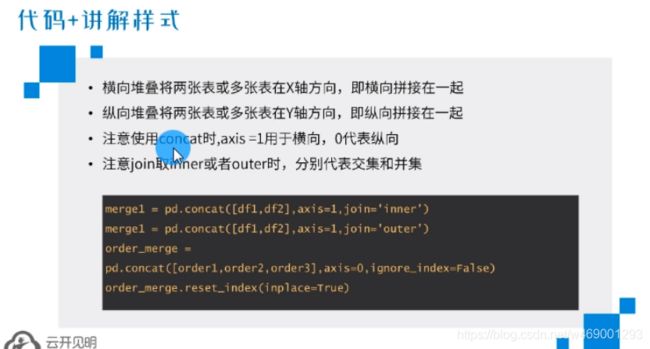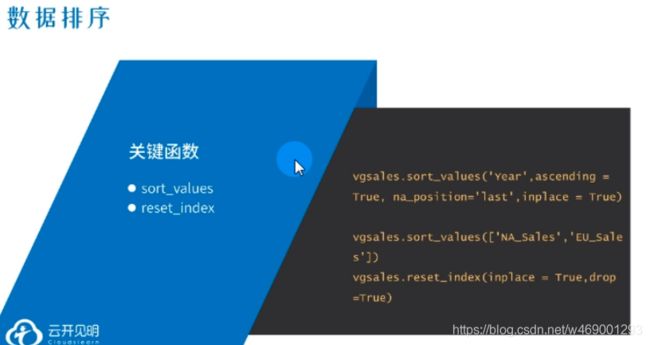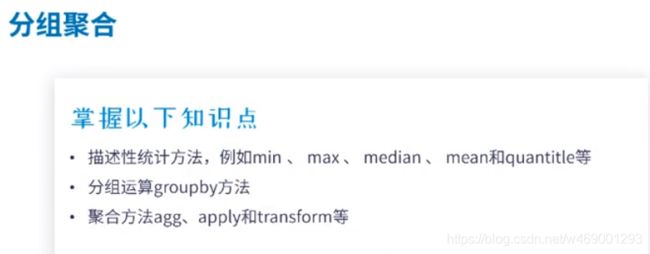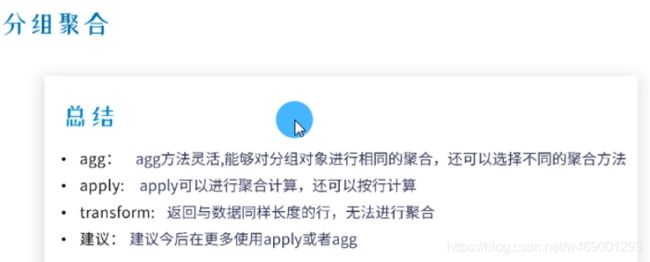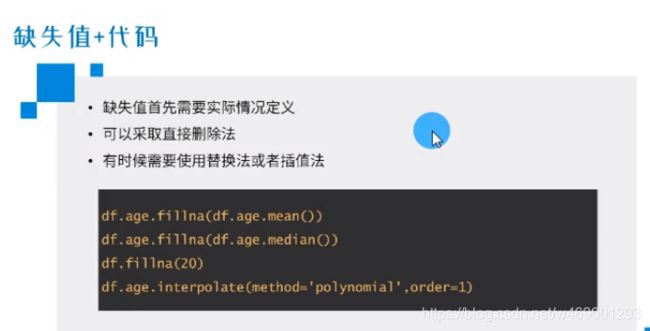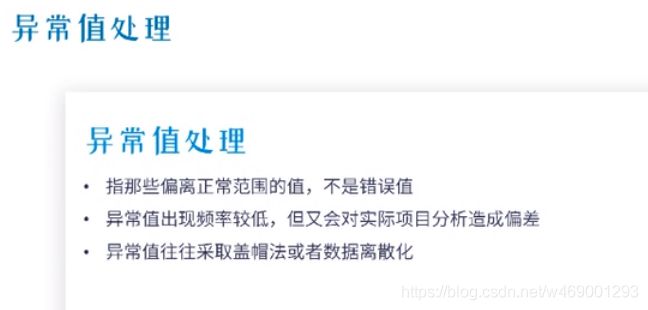第三章 Python Pandas数据分析运用
Python Pandas数据分析运用
- 三、Python Pandas数据分析运用
- 1. Pandas常用数据结构
- (1)Series类
- (2)Series常用属性
- (3)DataFrame类
- 2. 数据获取和保存
- 3. 数据筛选
- 4. 条件查询和增删改查
- 5. 数据库数据获取和保存
- 6. 数据整合
- 7. 层次化索引
- 8. 数据排序
- 9. 分组聚合
- 10. 透视图和交叉表
- 11. Pandas其他函数运用(日期 时间 变化率)
- 12. 重复值处理
- 13. 缺失值处理
- 14. 异常值处理
- 15. 数据离散化
三、Python Pandas数据分析运用
1. Pandas常用数据结构
创建一个series对象
- series1 = pd.Series([2.8,3.01,8.99,8.59,5.18]) #序列
- series2 = pd.Series([2.8,3.01,8.99,8.59,5.18], index = [‘a’,‘b’,‘c’,‘d’,‘e’],name=‘This is a series’)
#index:索引 - series6 = series4.append(series5) #增加
- series6.drop(‘四川’,inplace = True) #删除
series6.drop([‘浙江’,‘重庆’],inplace = True)

(1)Series类
(2)Series常用属性
(3)DataFrame类
- df1 = pd.DataFrame(list1,columns=[‘姓名’,‘年龄’,‘性别’]) #列表创建-数据框
- df1 = pd.DataFrame({‘姓名’:[“张三”,“李四”,“王二”], ‘年龄’:[“23”,“24”,“26”],
‘性别’:[“男”,“女”,“女”]},) #字典创建-数据框 - df2 = pd.DataFrame(array1,columns=[‘姓名’,‘年龄’,‘性别’],index=[“a”,“b”,“c”]) #数组创建-数据框
- df2.index.tolist() #数据结构转化为列表形式

2. 数据获取和保存
- os.getcwd() #getcwd:获取当前的路径
- os.chdir(‘E:\Python learn\10 Python数据分析\第3章 Pandas数据分析运用’) #chdir:路径前缀
- df.head(5) #head:查看前5行
- df.tail(5) #head:查看最后5行
- df.dtypes #dtypes:查看每行的类型
- df = pd.read_csv(r’autoshop_store.csv’,encoding = ‘gbk’,
dtype={‘id’:str,‘admin_id’:str}) #dtype:改变数据类型 - pd.__ version __ #pd的类型
- df = pd.read_csv(r’autoshop_store.csv’,encoding = ‘gbk’,
dtype={‘id’:str,‘admin_id’:str}, nrows=10,
sep=’,’) #sep:分隔符 - df = pd.read_csv(r’autoshop_store.csv’,encoding = ‘gbk’,
dtype={‘id’:str,‘admin_id’:str}, nrows=10,
sep=’,’,na_values=31) #na_values:缺失值,31变成NaN - sheet_name = [‘autoshop_store’ + str(i) for i in range(1,4)] #工作表内容显示
- for i in sheet_name:
data = pd.read_excel(‘autoshop_store1.xlsx’,encoding = ‘gbk’,
sheet_name = i,dtype={‘id’:str,‘admin_id’:str})
data_all = pd.concat([data_all,data],axis=0,ignore_index = True)
#concat,ignore_index??? - #保存
data_all.to_csv(‘data_all.csv’,index = False, encoding = ‘utf-8’)
3. 数据筛选
- order = pd.read_excel(‘autoshop_store1.xlsx’,encoding = ‘utf-8’,sheet_name=0,dtype={‘id’:str,‘admin_id’:str})
- order.columns #列名
- order.name #选择某个变量
- order[‘name’][:5] #选择列
- order[[‘id’,‘admin_id’,‘name’]][:5] #选择行
- #loc和iloc的用法
- order.loc[A,B] #A:行索引名称或者条件,列索引名称或者标签
- order.loc[order[‘order_id’]==2,[‘order_id’,‘admin_id’,‘name’]]
#??? - order.iloc[:,1:4] #iloc:行索引位置,列索引位置
4. 条件查询和增删改查
- order[[‘id’,‘store_id’,‘addtime’,‘nickname’,]][order[‘store_id’] == 36]
#获取’id’,‘store_id’,‘addtime’,'nickname’列,并’store_id’为36 - order[[‘id’,‘store_id’,‘addtime’,‘nickname’]][(order[‘store_id’] == 36) & (order[‘id’] > 124)]
- order[[‘id’,‘store_id’,‘addtime’,‘nickname’]][(order[‘store_id’] == 36) | (order[‘id’] > 124)]
- order[[‘id’,‘store_id’,‘addtime’,‘nickname’]][~(order[‘store_id’] == 36)]
- order[[‘id’,‘store_id’,‘addtime’,‘nickname’]][order[‘store_id’].between(10,30,inclusive=True)]
#between:获取store_id为10-30,开合 - order[[‘id’,‘store_id’,‘addtime’,‘nickname’]][order[‘nickname’].isin([‘学者’,‘文’])]
#isin:判断次数 - order[[‘id’,‘store_id’,‘addtime’,‘nickname’]][order[‘nickname’].str.contains(‘学’)]
#str.contains:判断字符串包含 - order[‘ceshi1’] = order[‘id’] * order[‘id’] #增加列
- order.drop(‘ceshi2’,axis=1,inplace = True)
#axis=1,删除列,沿每一行或者列标签值执行 - order.insert(0,‘x1’,mid) #insert插入列
- order.drop(labels = [3,4], axis = 0) #labels:删除行
- order.loc[order[‘store_id’] == 11,‘store_id’] =11000 #loc:批量修改值
- order.rename(columns={‘x1’:‘y1’},inplace = True) #rename:更改列标签名
- order.rename(index={0:‘0000’},inplace = True) #rename:更改行索引名
- order.describe()
#表统计:
#count:个数;
#mean:均值;
#std:标准差;
#min:最小值;
#25%:25,50,75中位数
#max:最大值 - order.describe().loc[‘count’] ==0 #True表示缺失
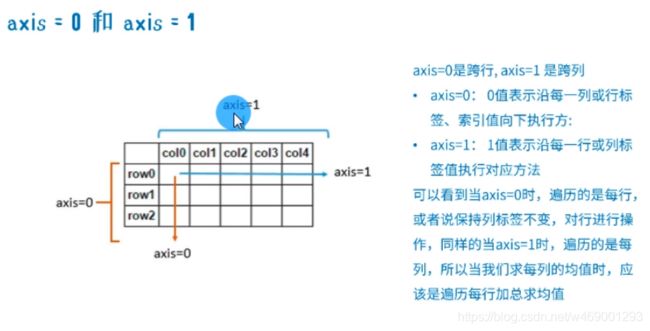
5. 数据库数据获取和保存
数据获取
- from sqlalchemy import create_engine
- create_engine(‘mysql+pymysql://user:passward@IP:3306/test01’)
- #建立连接
conn = create_engine(‘mysql+pymysql://root:709623@localhost:3306/jupyter_notebook’) - sql = ‘select * from autoshop_store’
- df1 = pd.read_sql(sql,conn)
- def query(table):
host = ‘localhost’
user = ‘root’
passward = ‘709623’
database = ‘jupyter_notebook’
port = 3306
conn = create_engine(‘mysql+pymysql://{}:{}@{}:{}/{}’.format(user,passward,host,port,database))
sql = 'select * from ’ + str(‘autoshop_store’)
results = pd.read_sql(sql,conn)
return results - df2 = query(‘autoshop_store’)
数据保存
- df = pd.read_csv(r’autoshop_store1.csv’,encoding = ‘gbk’)
- conn = create_engine(‘mysql+pymysql://root:709623@localhost:3306/jupyter_notebook’)
- try:
df.to_sql(‘autoshop_store_1’,con = conn,index = False,if_exist=‘replace’)
#命名表:autoshop_store_1
#建立连接:con(to_sql中)
#不用写索引:index = False
#表存在:替换(replace)、追加()、不加入()
except:
print(‘error’)
6. 数据整合
- df1 = pd.DataFrame({‘id’:[1,2,3,4,5],‘name’:[‘张三’,‘李四’,
‘王二’,‘丁一’,‘赵五’],‘age’:[27,24,25,23,25],‘gender’:[‘男’,‘男’,‘女’,‘男’,‘女’]}) - merged = pd.concat([df1,df2],axis=1,join=‘inner’) #inner:纵向交集
- merged = pd.concat([df1,df2],axis=1,join=‘outer’) #inner:纵向并集
- data = pd.concat([order1,order2,order3],axis=0,ignore_index = False)
#ignore_index = False,索引不变 - data = pd.concat([order1,order2,order3],axis=0,ignore_index = True)
#ignore_index = True,索引累加 - data.reset_index(drop = True,inplace = True) #重置索引
- mergel = pd.merge(left=df1,right=df2,how=‘right’,left_on=‘id’,right_on=‘Id’)
#how链接方式
#left_on:左边用什么做关联
#right_on:右边用什么做关联
#outer:全连接
#inner:内连接 - mergel = pd.merge(left=df1,right=df2,how=‘inner’,left_on=‘id’,right_on=‘Id’)
#sort = True,排序 - mergel = pd.merge(left=df1,right=df2,how=‘inner’,left_index=True,right_index=True)
#left_index:按照索引合并
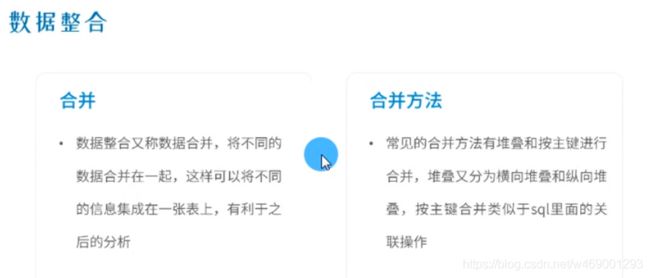
7. 层次化索引
- order = pd.read_excel(‘autoshop_store.xlsx’,encoding = ‘gbk’,sheet_name=0,header=0,
index_col=[0,1]) #index_col:行索引 - order.loc[1].loc[1] #两次索引引用
- order.loc[(1,1),:] #两次索引引用
- order.loc[(1,[1]),:] #两次索引引用
- order.loc[(a,[b,c]),[‘d’,‘e’]]
- order.loc[(a,[b,c]),‘d’]
- order.loc[(a,[b,c]),[‘d’]]

8. 数据排序
- vgsales.isnull() #isnull:判断是否缺失
- np.sum(vgsales.isnull(),asix=0) #判断空值的数
- vgsales.sort_values(‘admin_id’,ascending=True,na_position=‘last’,inplace=True)
#asccending:True按升序排列,False按降序排列
#na_position:last缺失值排最后,first缺失值排最前面 - vgsales.reset_index(drop=True,inplace=True) #索引重置
- vgsales.sort_values([‘A’,‘B’]) #A先升序,然后B再升序
9. 分组聚合
-
vgsales = pd.read_excel(‘autoshop_user.xlsx’,encoding=‘gbk’)
-
var_name = [‘id’,‘addtime’,‘store_id’]
-
median #求中位数
-
vgsales[var_name].min(axis=0) #max,median
-
vgsales[var_name].cumsum(axis=0) #cumsum:累加
-
vgsales[var_name].sum(axis=0) #总计
-
vgsales[var_name].quantile([0,0.2,0.5,1]) #quantile:求中位数
-
vgsales.describe() #describe:汇总
-
vgsales.describe(include= [‘object’])
#include= [‘object’]:计算统计量
#count:总数
#unique:元素值去重后数量
#top:出现最多的元素值
#freq:出现最多的元素值次数 -
groupde.count() #统计个数
-
groupde.size() #每个有几个样本
-
groupde.median().loc[([1980,1986],‘Fighting’),:]
-
groupde.agg([np.mean,np.sum]).head(5) #agg:聚合算法,mean,sum
-
groupde.agg([np.mean,np.sum]).loc[[2,3],(‘addtime’,[‘mean’,‘sum’])]
-
#自定义函数
def DoubleSUM(data):
s = data.sum()*2
return s
groupde.agg({‘addtime’:DoubleSUM})
vgsales[var_name].apply(np.sum,axis=0) #apply
vgsales[var_name].apply(lambda x: x[1] - x[2],axis=1) #第二列减去第三列 -
#transform函数
groupde.mean().transform(lambda x: x*2)
10. 透视图和交叉表
透视图
- pd.pivot_table(data=df,index=‘store_id’,columns=‘time’,values=‘id’,
aggfunc=np.mean,margins=True,fill_value=0,margins_name=‘总计求均值’)
#pivot_table:透视图,求均值、和
#index:行标签
#columns:列标签
#values:值
#aggfunc:聚合函数
#mean:均值;
#margins:是否需要总计
#fill_value:空值为0
#margins_name:总计名称 - pd.pivot_table(data=df,index=‘store_id’,columns=‘time’,values=‘id’,
aggfunc=[np.sum,np.median],margins=True,fill_value=0,margins_name=‘总计求均值’).head(10) - pd.pivot_table(data=df,index=[‘store_id’,‘time’],values=‘id’,
aggfunc=[np.sum,np.median],margins=True,fill_value=0,margins_name=‘总计求均值’).head(50)
交叉表
- pd.crosstab(index=df[‘name’],columns=df[‘id’],margins=True)
#crosstab:交叉表,求个数 - pd.crosstab(index=df2[‘name’],columns=df2[‘id’],normalize=‘all’,margins=True)
#normalize=‘all’:每个值出现的百分比 - pd.crosstab(index=df2[‘name’],columns=df2[‘id’],normalize=‘index’,margins=True)
#normalize=‘index’:行的百分比 - pd.crosstab(index=df2[‘name’],columns=df2[‘id’],normalize=‘columns’,margins=True)
#normalize=‘index’:列的百分比
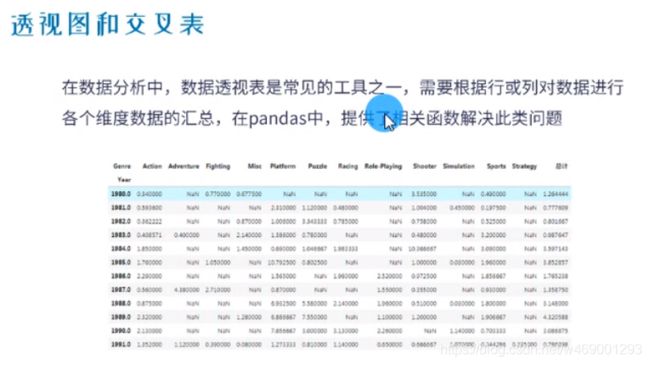
11. Pandas其他函数运用(日期 时间 变化率)
日期 时间
- sec_cars = pd.read_excel(‘autoshop_user2.xlsx’,encoding=‘gbk’,na_values=‘暂无’)
#na_values:空 - sec_cars[‘time’] = pd.to_datetime(sec_cars[‘time’],format = ‘%Y-%m-%d’,errors=‘coerce’)
#to_datetime:日期转化
#coerce:空值 - sec_cars[‘price’].unique() #unique:有哪些取值
- sec_cars[‘price’].value_counts() #出现次数
- sec_cars[‘price’] = sec_cars[‘price’].str[:-1].astype(‘float’) #astype(‘float’):去单位
- sec_cars[‘price’] = sec_cars[‘price’].str.replace(’–’,‘缺失值’) #替换
- sec_cars[‘diff_time’] = pd.datetime.today() - sec_cars[‘time’] #多少天
- sec_cars[‘diff_time’]/np.timedelta64(1,‘D’) #timedelta64(1,‘D’):天
- sec_cars[‘diff_time’]/np.timedelta64(30,‘D’) #timedelta64(30,‘D’):月
- (sec_cars[‘diff_time’]/np.timedelta64(1,‘D’)).astype(int) #去小数点
- sec_cars[‘diff_day’] = (sec_cars[‘diff_time’]/np.timedelta64(1,‘D’)).astype(int) #去小数点
- sec_cars[‘diff_year’] = pd.datetime.today().year - sec_cars[‘time’].dt.year
变化率
- df = pd.read_excel(‘autoshop_user2.xlsx’,dtype={‘telephone’:str,‘time’:‘datetime64’})
- df[‘telephone’] = df[‘telephone’].astype(str).apply(lambda x :x.replace(x[3:7],’****’))
#apply
#replace
#手机号中间用星号(*号) - df[‘email’] = df[‘email’].apply(lambda x: x.split(’@’)[1]) #split分隔
- df[‘new_tel’] = df[‘telephone’].str[0:3]
- df[‘telephone’].astype(str).apply(lambda x: x[0:3]) #取前三位
- data = df.sample(n = 1000,replace = False) #sample:抽样
- data[‘time’].dt.date #取日期
- data[‘time’].dt.time #取时间
- data[‘total_price’] = data[[‘quantity’,‘unitprice’]].apply(np.prod,axis=1) #prod:计算两个数相乘
- grouped_data = data.groupby(by = ‘time’).sum() #计算每天数据
- grouped_data.index = pd.to_datetime(grouped_data.index) #行索引转化为日期格式
- grouped_data[‘总价变化率’] = grouped_data[‘total_price’].pct_change() #总价变化率,下一行减上一上
- grouped_data[‘SMA_5’] = grouped_data[‘total_price’].rolling(5).mean() #计算5日的移动平均值
- grouped_data[‘SMA_10’] = grouped_data[‘total_price’].rolling(10).mean() #计算10日的移动平均值
- grouped_data[‘total_price_before’] = grouped_data[‘total_price’].shift(1)
#shift(-1)向上平移一个单位
#shift(1)向下平移一个单位 - (grouped_data[‘total_price’]-grouped_data[‘total_price’].shift(1))
- (grouped_data[‘total_price’].diff(1)
12. 重复值处理
- df.duplicated().head(10) #duplicated:判断行是否有无重复值
- df[df.duplicated(subset = [‘addtime’,‘nickname’],keep = ‘last’)].head(10) #subset:根据A.B值判断;keep:保留first(第一个),last(最后一个)
- np.sum(df.duplicated()) #duplicated:有多少重复值
- df.drop_duplicates().head(10) #drop_duplicates:删除重复值
- df[df.duplicated(subset = [‘addtime’,‘nickname’],inplace = True)].head(10)
13. 缺失值处理
- df.isnull() #缺失值判断
- np.sum(df.isnull())
- np.sum(df.isnull(),axis = 1)
- df.apply(lambda x: sum(x.isnull()) /len(x),axis=0)
- df.dropna() #一行有一个缺失值,就会被删除
- df.dropna(how = ‘any’,axis=1) #一列有一个缺失值,就会被删除
- df.dropna(how = ‘all’,axis=1) #一列全部缺失,就会被删除
- df.telephone.fillna(df.telephone.mean()) #fillna:填充均值(median)或中位值(mean)
- df.telephone.mode()[0] #mode出现次数最多的元素
- df.fillna(method=‘ffill’) #method=‘ffill’:前项填充
- df.fillna(method=‘bfill’) #method=‘bfill’:后项填充
- df.telephone.interpolate(method=‘linear’) #interpolate(method=‘linear’):差值法
- df.telephone.interpolate(method=‘polynomial’,order = 1) #差值,用的不多
14. 异常值处理
- xstd = df.unitprice.std() #std:标准差
- any(df.unitprice > xbar + 2*xstd) #判断有没有异常值
- Q1 = df.unitprice.quantile(q = 0.25) #下四分位数
- Q3 = df.unitprice.quantile(q = 0.75) #上四分位数
- IQR = Q3-Q1 #分位差
- any(df.unitprice > Q3 + 1.5*IQR) #True有异常值
- UL = Q3 + 1.5 * IQR
- replace_value = df.unitprice[df.unitprice < UL].max()
- df.loc[df.unitprice > UL,‘unitprice’] = replace_value
- P1 = df.unitprice.quantile(0.01)
- P99 = df.unitprice.quantile(0.99)
- df[‘unitprice_new’] = df[‘unitprice’]
- df.loc[df[‘unitprice’] > P99,‘unitprice_new’] = P99
- df.loc[df[‘unitprice’] < P1,‘unitprice_new’] = P1





